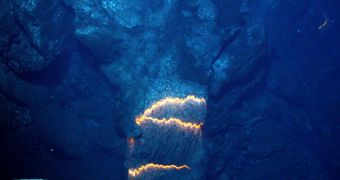In a new study of submarine volcanic eruptions, investigators at the Queensland University of Technology (QUT), in Australia, determined that ejecta rocks called pumice could act as life rafts or shuttles for lifeforms of all sizes to move through the ocean.
As soon as the results of the new research came in, experts started wondering about the long-term effects that traveling pumice could have on the development of coral reefs, as well as on the biodiversity of various regions.
QUT geologist Dr. Scott Bryan says that this is the first research to look at the role that volcanic rocks may have on promoting the health and recovery of marine ecosystems. His work established that even the Great Barrier Reef may have appeared as a result of volcanic eruptions.
As a case study, the Australian researchers used two volcanic eruptions that occurred in Tonga, in 2001 and 2006, respectively. Both events produced significant amounts of pumice, which then went on to flow westwards, spreading under the water.
Pumice can also float, since they form by cooling down rapidly. This process traps a large number of gas bubbles within the structure of the rock, making it very lightweight. Various animals and plants can easily attach themselves to these life rafts.
Investigators even found corals and clams on these small rocks, some of which were heading towards northeastern Australia. “The pumice raft created after the 2006 Home Reef volcano erupted in Tonga initially formed at least a 440 square kilometer floating mass,” Bryan explains.
Over time, the mass broke down into smaller parts, giving billions of marine organisms the chance to latch on, and be carried out. Lifeforms found attached to these rocks include crabs, corals, mollusks, anemones, barnacles and countless cyanobacteria.
After traveling 5,000 kilometers over the course of 900 days, the pumice arrived at the Great Barrier Reef, and were immediately incorporated in its structure. Corals, coralline algae, anemones and other reef organisms were the easiest to assimilate.
“This is good news because we know the reef is being replenished as a result of volcanic activity in the south-west Pacific and volcanic activity is frequent with eruptions in the area occurring every five to 10 years,” the team leader explains.
Details of the new study appear in a paper entitled “Rapid, Long-Distance Dispersal by Pumice Rafting,” which is published in the latest online issue of the peer-reviewed, open-access journal PLoS ONE.

 14 DAY TRIAL //
14 DAY TRIAL //